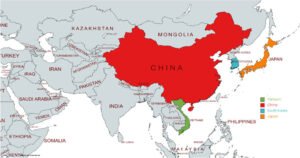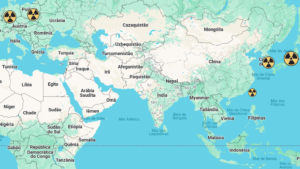- The system was initially established to monitor the communications of the Soviet Union and communist bloc countries;
- During the 1950s and 1960s, the alliance was kept secret, involving mainly Anglo-Saxon intelligence agencies;
- If misused, this technology can be exploited for indiscriminate surveillance, violating individual rights and national sovereignty.
The world of global intelligence is full of secrets, agreements and sometimes clandestine operations. At the epicenter of this universe is the US-led ECHELON program, a crucial piece in the cooperation known as the “5 Eyes.”
Therefore, it is important to analyze the origins, evolution and impact of this alliance on international relations and how it affects geopolitics. However, it is also necessary to consider the controversies of this complex collaboration.
What is the ECHELON intelligence sharing program of the United States, Canada, the United Kingdom, Australia, and New Zealand?
The ECHELON intelligence sharing program is an integral part of intelligence cooperation among the United States, Canada, the United Kingdom, Australia, and New Zealand, collectively known as the “Five Eyes” alliance.
ECHELON is a global communications interception system aimed at the massive collection of electronic information. Here are some key points about the program:
- Origins and Purpose: The system originated during the Cold War and was initially established to monitor communications from the Soviet Union and communist bloc countries. Over time, the program expanded its scope to include the interception of global communications.
- Surveillance Capabilities: The ECHELON program is known for its advanced interception and electronic surveillance capabilities. It aims to monitor a wide range of communications, including phone calls, emails, faxes, radio communications, and other forms of electronic communication.
- Global Reach: The system operates on a global scale, allowing participating countries to monitor communications worldwide. To achieve this, interception facilities and stations are strategically distributed around the world to ensure comprehensive coverage.
- Expansion of Cooperation: In addition to the Five Eyes alliance, the system has undergone expansions of intelligence cooperation to include other countries, forming categories such as “Nine Eyes,” “Fourteen Eyes,” and “Forty-One Eyes,” indicating an increase in the number of countries involved in collaboration.
How the “Five Eyes” transitioned from a post-World War II conspiracy to reality
As the geopolitical landscape evolved during the Cold War, Canada, Australia, and New Zealand joined an existing alliance between the United States and the United Kingdom. The term “Five Eyes” was formally coined in 2010 when the existence of the alliance was revealed to the public. However, the path to consolidating this global espionage group was a complex journey that went through various phases.
As mentioned, the alliance’s primary goal was to monitor communications from the Soviet Union during the Cold War. This information-sharing aimed to strengthen defenses against a potential communist threat. During the 1950s and 1960s, the alliance was kept secret, involving primarily the intelligence agencies of the member countries.
Secrecy surrounding the Five Eyes was a fundamental part of its operation. Intercepting, collecting, analyzing, and decrypting information activities were protected by secret agreements, thus bypassing domestic legal restrictions on state surveillance.
The lack of national legislation regulating intelligence sharing often left these agreements legally lacking and, consequently, lacking democratic legitimacy.
Over the decades, the alliance expanded. First, with the “Nine Eyes” (adding Denmark, France, the Netherlands, and Norway), then with the “Fourteen Eyes” (introducing Germany, Belgium, Italy, Spain, and Sweden), and even the “Forty-One Eyes,” including the allied coalition in Afghanistan.
However, the price of this expansion was the growing controversy surrounding the group’s practices. Revelations over time highlighted not only success in defeating Soviet spies but also darker operations contributing to global instability.
The alliance, often centered on its defensive image, found itself potentially involved in controversial episodes, from possible orchestrations of coups to participation in conflicts in the Middle East.
The transformation of the Five Eyes from a post-World War II conspiracy to a global operational reality reflects not only changes in international security dynamics but also the ethical and legal complexities surrounding its activities and the difficulty of keeping secrets in an era of mass communication.
The potential capability of the ECHELON program to gather intelligence via text, voice, and image
The ECHELON program is also known for its potential capability to gather intelligence through text, voice, and image on a global scale.
The system operates by intercepting electromagnetic communications, including phone calls, emails, faxes, satellite data, and other forms of information transmission.
- Text Interception:
- Electronic Communications: The system can intercept and analyze electronic communications, such as emails and text messages via applications, searching for relevant information.
- Keywords: The program uses advanced filtering systems that identify specific keywords, allowing efficient screening of large volumes of data to identify communications of interest.
- Voice Interception:
- Image Interception:
- Satellite Surveillance: The system is capable of intercepting and analyzing images from satellites, enabling monitoring of activities in specific areas.
- Image Analysis: Advanced image analysis tools can be employed to identify patterns, movements, and objects of interest.
The potential capability of ECHELON to gather intelligence through these diverse modes of communication raises significant concerns about privacy and the legality of operations.
Operating globally and due to its secretive nature, the system often escapes national legal restrictions. Therefore, information sharing among the Five Eyes member countries amplifies these concerns, as it may bypass legal protections present in a specific nation.
Intelligence failures of the “Five Eyes”
The intelligence agencies of the “Five Eyes” had several failures throughout their history, despite their declared mission to ensure national security through information sharing.
Some of these failures include:
- Iraq War and Weapons of Mass Destruction:
- One of the most significant failures was the involvement of the Five Eyes in the Iraq War in 2003 based on erroneous information about Saddam Hussein’s possession of weapons of mass destruction—leading critics to believe that this information was already known, and the real purpose of the invasion was economic, such as oil.
- These later-deemed nonexistent pieces of information were shared among the members, highlighting a critical failure in intelligence assessment.
- September 11, 2001 Attacks:
- Intelligence agencies failed to prevent the terrorist attacks on September 11, 2001, in the United States, despite prior warning signs.
- Ineffective information sharing between agencies and the inability to connect crucial dots contributed to this failure.
- London Bombings in 2005:
- The terrorist attacks in London in 2005, known as 7/7, caught intelligence agencies off guard.
- There were criticisms of the failure to identify and monitor the involved terrorists, highlighting gaps in the ability to predict and prevent domestic attacks.
- Terrorist Attacks in Christchurch, New Zealand (2019):
- The mosque attacks in Christchurch, New Zealand, in 2019 were a surprise to intelligence agencies.
- The inability to anticipate and prevent these “lone wolf” attacks underscores the difficulty in dealing with emerging threats, especially those from individual extremists.
These failures highlight the challenges of effective collection, analysis, and interpretation of intelligence information.
The complexity of the global scenario is believed to overwhelm the data, and in some cases, the lack of cooperation between agencies contributed to lapses with significant consequences in terms of security and stability.
The geopolitical importance of the Anglo-Saxon intelligence alliance via the ECHELON program
The intelligence alliance known as the “Five Eyes,” operating through the ECHELON program, has become an important part of global geopolitics, particularly in the Anglo-Saxon sphere.
The implications of the alliance are profound in various aspects:
- International Cooperation: The alliance not only strengthens ties among member countries but also allows close cooperation with other states that share similar interests. The “Nine Eyes,” “Fourteen Eyes,” and “Forty-One Eyes” expand this collaboration to include additional nations, strengthening the position of these countries in the international arena.
- Counterterrorism and National Security: The alliance uses ECHELON to combat terrorist threats and safeguard national security. Intelligence sharing among member countries enhances the ability to identify and neutralize potential risks to regional and global stability.
- Influence in Diplomatic Relations: Possession of sensitive information through ECHELON provides a significant advantage in diplomatic negotiations. Prior knowledge of the positions and strategies of other countries allows for a more informed and assertive approach in bilateral and multilateral agreements.
- Economic Intelligence and Global Competition: In addition to security issues, ECHELON plays a role in obtaining economic intelligence. Information on trade policies, technological developments, and economic strategies of other nations contributes to a competitive advantage in economic and industrial realms.
- Developments in the Digital Age: With the increasing importance of digital communications, ECHELON becomes even more relevant. The ability to monitor and analyze online data gives the alliance a unique position in understanding global digital dynamics.
However, it is essential to consider the risks associated with the lack of transparency, potential hidden agendas, and inherent flaws in massive intelligence systems. Some of these risks include:
- Lack of Transparency: ECHELON operates largely in secrecy, raising concerns about the lack of transparency and accountability. This can result in unregulated activities and even abuses, bypassing national and international privacy laws.
- Political and Economic Exploitation: Almost unrestricted access to confidential information can be exploited for political and economic gains. Industrial espionage and gathering information on other countries’ policies can be dishonestly used to gain geopolitical advantages.
- Intelligence Failures: Despite its comprehensiveness, ECHELON is not infallible. Examples such as those mentioned earlier highlight significant failures in interpreting information, leading to misguided political decisions. Excessive reliance on collected intelligence can result in inaccurate assessments.
- Potential for Abuses: ECHELON’s ability to gather intelligence via text, voice, and image raises ethical and privacy concerns. If misused, this technology can be exploited for indiscriminate surveillance, violating individual rights and national sovereignty.
Ultimately, the Five Eyes alliance and the ECHELON program have a profound impact on global security and geopolitics. However, there must be a balanced pursuit between security, preserving individual rights, and maintaining the national sovereignty of the involved countries. In this way, the legality and legitimacy of this alliance can be ensured in the geopolitical arena.










[…] computerized processing, expanding its reach and capabilities for global surveillance. The system was designed to function as a covert and comprehensive global interception network, capable of collecting vast amounts of […]
[…] The Real History of the ECHELON Program: The “5 Eyes” Global Espionage Alliance […]